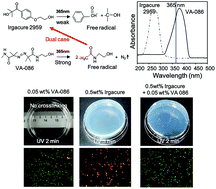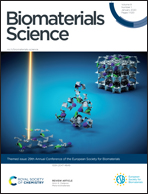Improved cell viability for large-scale biofabrication with photo-crosslinkable hydrogel systems through a dual-photoinitiator approach†
Abstract
Biofabrication with various hydrogel systems allows the production of tissue or organ constructs in vitro to address various challenges in healthcare and medicine. In particular, photocrosslinkable hydrogels have great advantages such as excellent spatial and temporal selectivity and low processing cost and energy requirements. However, inefficient polymerization kinetics of commercialized photoinitiators upon exposure to UV-A radiation or visible light increase processing time, often compromising cell viability. In this study, we developed a hydrogel crosslinking system which exhibited efficient crosslinking properties and desired mechanical properties with high cell viability, through a dual-photoinitiator approach. Through the co-existence of Irgacure 2959 and VA-086, the overall crosslinking process was completed with a minimal UV dosage during a significantly reduced crosslinking time, producing mechanically robust hydrogel constructs, while most encapsulated cells within the hydrogel constructs remained viable. Moreover, we fabricated a large PEGDA hydrogel construct with a single microchannel as a proof of concept for hydrogels with vasculature to demonstrate the versatility of the system. Our dual-photoinitiator approach allowed the production of this photocrosslinkable hydrogel system with microchannels, significantly improving cell viability and processing efficiency, yet maintaining good mechanical stability. Taken together, we envision the concurrent use of photoinitiators, Irgacure 2959 and VA-086, opening potential avenues for the utilization of various photocrosslinkable hydrogel systems in perfusable large artificial tissue for in vivo and ex vivo applications with improved processing efficiency and cell viability.



 Please wait while we load your content...
Please wait while we load your content...